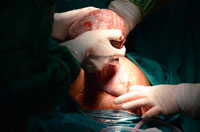 A baby was born by caesarean section at 27 weeks gestation with a birth weight of
A baby was born by caesarean section at 27 weeks gestation with a birth weight of 980grams. The baby was intubated, ventilated and endotracheal surfactant was administered.
980grams. The baby was intubated, ventilated and endotracheal surfactant was administered.
During the first four hours of life, the baby’s oxygen saturations were recorded as ranging between 90-97%. A blood gas taken five hours after delivery showed a pH of 7.68 (normal 7.3-7.4), a PaCO2 of 1.91kPa (normal 4.5-6.0), a PaO2 of 35.84kPa (normal 5-8) and a bicarbonate level of 24.6mmol/L (normal 18-24). This demonstrated the baby was being over-ventilated.
The baby was ventilated for three days, placed on continuous positive airway pressure (CPAP), and then placed on 0.5L nasal cannula oxygen due to recurrent apnoeic spells. Overall the baby received 204 hours of oxygen with oxygen saturation levels of 96-100% throughout.
The baby was not referred at four to six weeks of age for retinopathy of prematurity (ROP) screening, and was first seen by an ophthalmologist at the age of seven months when a diagnosis of inoperable Grade 5 ROP, causing blindness, was made. The baby’s parents made a claim against the consultant paediatrician who handled the baby’s care.
Expert opinion
The baby had inappropriately high transcutaneous oxygen saturation levels and PaO2 levels for a period of 204 hours. During oxygen administration to premature infants, very high blood oxygen levels can develop if saturation levels rise above 96%. Weaning of the Fraction of Inspired Oxygen (FiO2) seldom occurred despite oxygen saturation levels of between 96% and 100%, indicating that the nursing staff had no protocol for weaning of oxygen according to oxygen saturation.
There was no record that an ophthalmological appointment for the screening of ROP was made at the recommended four to six weeks of age. The baby developed severe ROP and blindness due to excessive oxygen administration. The opportunity to limit the condition and save the infant’s vision was missed due to the fact that the child was not referred for screening for ROP.
There was negligence on the part of the paediatrician and nursing, in allowing the baby to be exposed to unnecessarily high oxygen levels in his blood over a four-day period, and for not referring the child at the appropriate time for an eye examination. The case was settled for a substantial sum.
Learning points
- Neonatal units should have written guidelines for oxygen saturation levels during the administration of oxygen to very low birth weight premature infants, and these must be adhered to.
- Attention should be paid to weaning oxygen when the saturation levels are more than 95%. The recommended safe levels of oxygen saturation in very premature, low birth weight infants are between 86%-92%. Unrestricted and prolonged oxygen exposure in very low birth weight infants is significantly associated with severe grades of ROP.
- ROP is a retinal disease that affects premature infants, and can be limited by adhering to the specific guidelines for oxygen administration and by screening of premature infants at four to seven weeks of age by an ophthalmologist experienced in the identification and treatment of ROP.